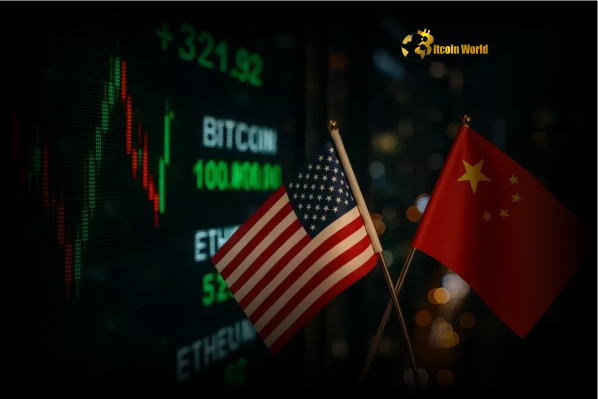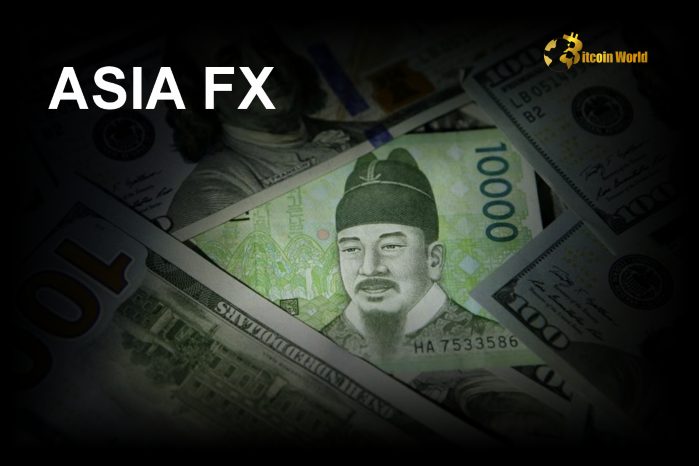BitcoinWorld

Asia FX Outlook: Rupee’s Remarkable Recovery Amidst Global Volatility
In the dynamic world of finance, where every tick of the clock can signal significant shifts, understanding macro-economic forces is paramount, even for those deeply entrenched in the cryptocurrency space. Just as Bitcoin and other digital assets react to global sentiment, so too do traditional currencies. Recently, the Asia FX Outlook has been a subject of keen interest, with many regional currencies experiencing slight weakening, while the Indian Rupee has staged a notable recovery from its recent record lows. This intriguing development is largely attributed to the Reserve Bank of India’s (RBI) strategic decision to hold interest rates steady, providing a much-needed anchor in turbulent waters. But what exactly does this mean for the broader financial landscape, and how does it connect to the overarching themes of economic stability and growth?
Decoding the Shifting Tides of Asia FX Outlook
The past few weeks have seen a nuanced performance across Asian foreign exchange markets. While some currencies have shown resilience, others have succumbed to external pressures, reflecting the complex interplay of global economic forces. The general sentiment has been one of slight weakening across the board, influenced by factors such as a strong US dollar, rising commodity prices, and persistent inflation concerns. This broader trend sets the stage for understanding the individual performances within the region.
- External Pressures: A robust US dollar, fueled by expectations of continued hawkishness from the Federal Reserve, often puts downward pressure on emerging market currencies.
- Commodity Price Volatility: Fluctuations in oil and other commodity prices can significantly impact the trade balances of net importers or exporters in Asia, affecting their currency valuations.
- Inflationary Concerns: Rising inflation in various Asian economies prompts central banks to consider tighter monetary policies, which can attract or deter foreign investment based on interest rate differentials.
- Geopolitical Developments: Ongoing global events and geopolitical tensions contribute to uncertainty, leading investors to seek safer assets, often at the expense of riskier emerging market currencies.
Despite these headwinds, the regional Asia FX Outlook remains a critical barometer for global economic health, with each currency’s movement telling a unique story of domestic policy and international influence.
Indian Rupee Recovery: A Resilient Comeback Story
Amidst the general weakening trend in Asia, the Indian Rupee Recovery stands out as a significant event. After touching a record low against the US dollar, the rupee has demonstrated remarkable resilience, bouncing back in a manner that has surprised many market observers. This recovery is not merely a statistical anomaly but a testament to underlying economic strengths and proactive policy measures.
The rupee’s journey from its nadir has been closely watched. Several factors contributed to its initial decline, including a widening trade deficit, sustained foreign institutional investor (FII) outflows from Indian equities, and the broad strengthening of the US dollar. However, the recovery phase has been underpinned by:
- Strong Inflows: A resurgence of foreign direct investment (FDI) and portfolio inflows, particularly into debt markets, has provided crucial support.
- Improved Economic Data: Positive domestic economic indicators, such as robust GDP growth figures and declining inflation (even if gradual), have bolstered investor confidence.
- RBI’s Intervention: The central bank’s strategic interventions in the forex market, including selling dollars from its reserves, have helped stabilize the currency.
- Export Performance: A healthy performance in key export sectors has helped narrow the trade deficit, reducing pressure on the rupee.
This Indian Rupee Recovery highlights the dynamic nature of currency markets and the significant impact of both internal economic health and external market forces.
RBI Monetary Policy: The Anchoring Force of Stability
At the heart of the Indian Rupee’s recent stability and recovery lies the RBI Monetary Policy. The Reserve Bank of India’s decision to maintain the repo rate at 6.5% for the eighth consecutive time played a pivotal role in calming market jitters and providing a sense of predictability. This decision, announced after careful consideration of inflationary pressures and growth prospects, signals a cautious yet confident approach by the central bank.
The RBI’s approach can be understood through these key points:
- Inflation Management: While inflation has shown signs of moderation, the RBI remains vigilant, aiming to bring it within its target range sustainably. Holding rates steady allows the central bank to assess the impact of previous rate hikes without stifling nascent economic growth.
- Growth Support: By not raising rates further, the RBI avoids adding to borrowing costs for businesses and consumers, thereby supporting economic expansion and investment.
- Exchange Rate Stability: A stable interest rate environment reduces interest rate volatility, which in turn helps stabilize the rupee. Predictable rates make India an attractive destination for foreign capital seeking reasonable returns.
- Global Cues: The RBI also considers global monetary policy trends, particularly those of major central banks like the US Federal Reserve. Aligning its policy helps prevent excessive capital outflows.
The steadfastness of the RBI Monetary Policy demonstrates a commitment to balancing price stability with economic growth, a crucial factor in attracting and retaining foreign investment.
Navigating Global Forex Trends and Their Local Impact
The performance of Asian currencies, including the Indian Rupee, cannot be viewed in isolation. They are deeply intertwined with Global Forex Trends, which are influenced by a myriad of factors ranging from geopolitical tensions to shifts in major economies’ monetary policies. Understanding these broader trends is essential for grasping the local impact on currencies.
Consider the following:
| Global Factor | Impact on Asia FX | Specific Effect on Rupee |
|---|---|---|
| US Dollar Strength | Puts downward pressure on most Asian currencies as capital flows to safe-haven assets. | Increases import costs, widens trade deficit, puts depreciation pressure. |
| Oil Price Fluctuations | Net oil importers (e.g., India, Japan) face currency depreciation; exporters (e.g., Malaysia) see appreciation. | Higher oil prices worsen current account deficit, increasing rupee vulnerability. |
| China’s Economic Performance | Significant impact on regional trade and investment flows, affecting currencies of trade partners. | Slowdown in China can reduce demand for Indian exports, impacting rupee. |
| Geopolitical Events | Increases risk aversion, leading to capital flight from emerging markets. | Can trigger sudden outflows, leading to sharp depreciation. |
The intricate dance of Global Forex Trends means that even strong domestic policies must contend with external headwinds. India’s ability to navigate these trends speaks volumes about its economic resilience and policy frameworks.
Understanding Currency Market Volatility: What Drives the Swings?
The very nature of foreign exchange markets is defined by Currency Market Volatility. Currencies are constantly in motion, responding to an endless stream of economic data, political developments, and market sentiment. For investors, understanding the drivers of this volatility is key to making informed decisions.
Key drivers of currency fluctuations include:
- Interest Rate Differentials: Higher interest rates in one country relative to another can attract foreign capital, strengthening its currency.
- Economic Performance: Strong GDP growth, low unemployment, and stable inflation generally lead to a stronger currency, as the economy is perceived as healthy.
- Political Stability: Countries with stable political environments are often seen as safer investments, attracting capital and strengthening their currency. Conversely, political instability can lead to rapid depreciation.
- Trade Balances: A country with a persistent trade surplus (exports exceeding imports) tends to see its currency strengthen due to higher demand for its goods and services.
- Speculation: Large-scale speculative trading by financial institutions can significantly amplify currency movements, sometimes detached from economic fundamentals.
While Currency Market Volatility presents risks, it also creates opportunities for investors who can accurately anticipate or react to these movements. The Indian Rupee’s recent journey is a prime example of how various factors converge to create significant shifts in value.
Challenges and Opportunities in the Current Landscape
The current financial landscape, characterized by both global uncertainties and pockets of resilience, presents a mix of challenges and opportunities for investors and policymakers alike.
Challenges:
- Sustained US Dollar Strength: The persistent strength of the US dollar continues to exert pressure on emerging market currencies, making imports more expensive and potentially fueling inflation.
- Global Inflationary Pressures: While some countries are seeing inflation cool, the risk of resurgence from supply chain disruptions or geopolitical events remains.
- Capital Outflows: Higher interest rates in developed economies could lead to continued capital outflows from emerging markets, putting pressure on their currencies and equity markets.
- Geopolitical Risks: Ongoing conflicts and trade tensions introduce uncertainty, deterring foreign investment and increasing market volatility.
Opportunities:
- Resilient Domestic Demand: Economies with strong domestic consumption can cushion against global slowdowns, offering attractive investment opportunities.
- Policy Stability: Central banks like the RBI, demonstrating consistent and predictable monetary policy, enhance investor confidence and attract long-term capital.
- Diversification: For global investors, the performance of currencies like the Indian Rupee offers diversification benefits, especially if they show decoupling from broader negative trends.
- Technological Advancements: Digitalization and innovation in various sectors can drive productivity gains and attract investment, strengthening economic fundamentals.
Navigating this complex environment requires a nuanced understanding of both macro-economic indicators and specific policy responses.
Actionable Insights for the Savvy Investor
For those looking to make sense of these currency dynamics, here are some actionable insights:
- Monitor Central Bank Communications: Pay close attention to statements from central banks like the RBI and the Federal Reserve. Their forward guidance on interest rates and inflation targets can provide crucial clues about future currency movements.
- Track Trade and Current Account Data: A country’s trade balance and current account deficit/surplus are strong indicators of its currency’s health. Improving figures often signal potential appreciation.
- Diversify Your Portfolio: While the Indian Rupee shows strength, maintaining a diversified portfolio across different asset classes and geographies can mitigate risks associated with single-currency exposure.
- Consider Long-Term Fundamentals: Short-term volatility can be distracting. Focus on the long-term economic fundamentals of a country, such as GDP growth, fiscal health, and policy stability, when making investment decisions.
- Stay Informed on Geopolitics: Geopolitical events can have swift and significant impacts on currency markets. Staying abreast of global news can help anticipate potential shifts.
By applying these insights, investors can better position themselves to capitalize on the opportunities presented by evolving currency markets.
Conclusion: A Remarkable Recovery in a Volatile World
The recent performance of the Asia FX Outlook, particularly the compelling Indian Rupee Recovery from its record lows, offers a fascinating case study in economic resilience and strategic central banking. The RBI Monetary Policy, characterized by its steady hand on interest rates, has proven instrumental in providing stability amidst a backdrop of fluctuating Global Forex Trends and persistent Currency Market Volatility. This delicate balance between supporting growth and managing inflation is a tightrope walk that the RBI has managed with notable success, instilling confidence in both domestic and international investors.
While the broader Asian currencies faced slight headwinds, India’s economic fundamentals, coupled with timely policy interventions, allowed the rupee to chart a distinct and positive course. This remarkable comeback serves as a reminder that even in an interconnected global economy, strong domestic policies and robust economic indicators can provide a crucial buffer against external shocks. As we move forward, monitoring these trends will be vital for understanding the broader implications for investment, trade, and economic stability across the region.
To learn more about the latest Forex market trends, explore our article on key developments shaping the Indian Rupee and global interest rates for future liquidity and institutional adoption.
This post Asia FX Outlook: Rupee’s Remarkable Recovery Amidst Global Volatility first appeared on BitcoinWorld and is written by Editorial Team





